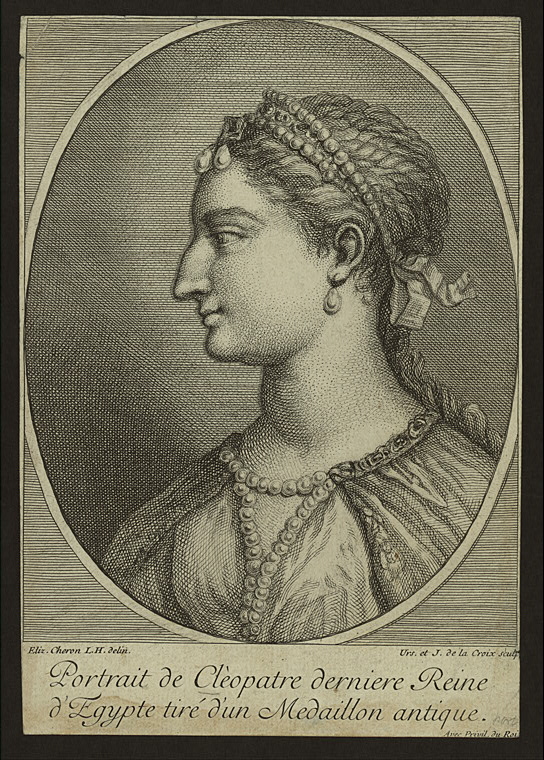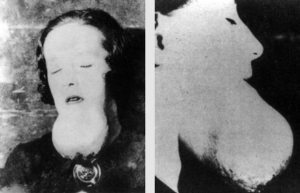When people hear the name Cleopatra, they often associate this name with a woman whose charms and seduction powers led her to bedazzle two of the most powerful men in Roman history, Julius Caesar, and Mark Antony. But what were her intentions in her entanglements with these two important historical figures? Roman history portrays her as a woman “foolish enough to think that she might one day rule Rome, and devious enough to lure a decent man (Caesar) away from his heart and home.” 1 This depiction, however, does not entirely describe the woman who could control and keep one of the most significant empires in history. Cleopatra’s relationships with Julius Caesar and Mark Antony provided her with resources to reestablish a strong Egyptian empire, which, despite her efforts, would later come to an end with her death. Cleopatra’s portrayal in history has been limited to her relationship with these two Roman generals, and Roman historians have generally given her a bad reputation.2 There has been little emphasis on other aspects of her life, her accomplishments, and her reign as the last queen of the Egyptian empire.

Cleopatra VII was the last monarch of Egypt, and many would think that she was, therefore, Egyptian, but what many may not know is that she was actually Greek. Born in Alexandria, Egypt, Cleopatra was a direct descendant of the Macedonian Ptolemaic dynasty.3 The Ptolemies had ruled Egypt since the death of Alexander the Great in the early fourth century B.C.E. Cleopatra was not only the last monarch of Egypt but also the last Ptolemaic ruler.4 She was also the only Ptolemaic ruler who learned the Egyptian language.5
When Ptolemy XII Auletes (Cleopatra’s father) died in 51 B.C.E., the throne of Egypt was taken by the seventeen-year-old Cleopatra and her brother, the ten-year-old Ptolemy. The two of them then ruled as Cleopatra VII and Ptolemy XIII.6 Brother and sister ruling together did not mean problems would be limited. In fact, a few years after Cleopatra and Ptolemy took the throne of Egypt, Ptolemy started a new dating system, and he also claimed sole rule of Egypt from his father’s death. In the summer of 49 B.C.E., Cleopatra’s name disappeared from all Egyptian official documents, and Ptolemy XIII proclaimed himself as the sole ruler of Egypt, forcing Cleopatra to leave Alexandria.7 This event was what led her to meet Julius Caesar. As a Roman officer, Caesar had the power of intervening in the problems between Cleopatra and her brother. His attempts would have been successful if not for the intervention of Ptolemy’s allies who opposed allowing Cleopatra to rule again. After the known Alexandrian War, Cleopatra was restored by Caesar to the throne of Egypt after the death of her brother Ptolemy XIII in the war.8 These events started Cleopatra’s relationship with Caesar, a romance from which Caesarion, the first son of Cleopatra, was the fruit. Cleopatra’s relationship with Caesar not only gave her back control over Egypt, but it also meant protection from Rome; and for Caesar, it meant an access to Egypt’s wealth.9

Besides the power she gained from her relationship with Caesar, Cleopatra’s marriage with Mark Antony, after Caesar’s death, led her to accomplish the restoring of the Egyptian empire. Mark Antony believed that the greatness of the Roman empire “consisted more in giving than taking.”10 Based on this belief, Antony gave his new wife, Cleopatra, extensions of land stretching from the Mediterranean coast, “from Cilicia, through Syria and Phoenicia, large past of Judaea, Lebanon and the Arab state of Ituraea.”11 Cleopatra’s intentions in restoring Egypt were also manifested by the names she chose for her children. Her first son, Caesarion, was named after Julius Caesar, claiming that her son was indeed the son of this important Roman figure.12 She also had three more children with Mark Antony. Their names also reflected Cleopatra’s ambitions. The twins, Alexander Helios and Cleopatra Selene, were named in honor of her family lineage. Alexander Helios was named after Alexander the Great as the sun god Helios. This character represented the role model of Ptolemy III, who extended the power of the Ptolemaic rulers to its greatest extent. In the same way, the name of Cleopatra Selene was inspired from the goddess Isis, a figure that had represented and ruled most of the region within the Ptolemaic and Seleucid lineage. For this reason, Cleopatra Selene was the most convenient name to manifest Cleopatra’s attempts to unify Egypt and Syria under her control.13 Her last child was named Ptolemy Philadelphus, named after the man who had ruled the territories she obtained when she married with Mark Antony.14

Cleopatra’s relationship with Mark Antony, although it gave her power and control over a large number of territories, also brought the end of her reign and, consequently, the end of the Egyptian empire. When Antony established that Caesarion and his three children with Cleopatra would rule Egypt and the Roman provinces in Asia minor, Octavian, adoptive child of Caesar and Antony’s first wife’s half-brother, declared war on both Antony and Cleopatra. The known Battle of Actium in 31 B.C.E. went badly for Antony, and it started the fall of Egypt and her queen. When Cleopatra realized her defeat was inevitable, she committed suicide in 30 B.C.E., marking the end of the Ptolemaic rule and the fall of Egypt to Roman control.15

Undoubtedly, Cleopatra was very intelligent in relating with both Julius Caesar and Mark Antony, and by consequence obtaining great power and control. She may have recognized that the aid of two of the most important Roman generals could eventually lead her to achieve her ambitions of extending the Egyptian empire.16 However, she never accomplished her intentions. Her ambitions were strongly highlighted by her relationship with the two Roman generals, and these two men provide her with the resources she needed to obtain the establishment of a stronger Egypt. Her determination in achieving what she aimed for is admirable.
Although Roman history has portrayed her as a bad woman dangerous for Rome, as followed by the propaganda of Octavian,17 Cleopatra not only related herself with two of the most important men in Roman history, but she also created a pathway towards the unification of a kingdom. She might have been successful if not for the events that led to the fall of her reign.
- Joyce A. Tyldesley, Cleopatra: Last Queen of Egypt (New York: Basic Books, 2008), 206. ↵
- Salem Press Biographical Encyclopedia, January 2015, s.v. “Cleopatra VII,” by Frances Stickney Newman. ↵
- J. Fletcher, Cleopatra the Great: The Woman behind the Legend (New York: HarperCollins, 2011), I. ↵
- Salem Press Biographical Encyclopedia, January 2015, s.v. “Cleopatra VII,” by Frances Stickney Newman. ↵
- Salem Press Encyclopedia, January 2015, s.v. “Ptolemaic Dynasty,” by Milton Berman. ↵
- Salem Press Biographical Encyclopedia, January 2015, s.v. “Cleopatra VII,” by Frances Stickney Newman. ↵
- Tyldesley, Cleopatra: Last Queen of Egypt, 48. ↵
- Salem Press Biographical Encyclopedia, January 2015, s.v. “Cleopatra VII,” by Frances Stickney Newman. ↵
- Tyldesley, Cleopatra: Last Queen of Egypt, 57. ↵
- Fletcher, Cleopatra the Great: The Woman behind the Legend, 268. ↵
- Fletcher, Cleopatra the Great: The Woman behind the Legend, 268. ↵
- Salem Press Biographical Encyclopedia, January 2015, s.v. “Cleopatra VII,” by Frances Stickney Newman. ↵
- Fletcher, Cleopatra the Great: The Woman behind the Legend, 264. ↵
- Fletcher, Cleopatra the Great: The Woman behind the Legend, 270. ↵
- Salem Press Biographical Encyclopedia, January 2015, s.v. “Cleopatra VII,” by Frances Stickney Newman. ↵
- Salem Press Biographical Encyclopedia, January 2015, s.v. “Cleopatra VII,” by Frances Stickney Newman. ↵
- For a clear example of Octavian’s propaganda, see Book IV of Virgil’s Aeneid and his portrayal of the African queen of Carthage, Dido. ↵



58 comments
Alyssa Almaguer
I feel like Hollywood is the reason why no one thinks of Cleopatra’s accomplishments, just her beauty (especially since she was played by Elizabeth Taylor), but this article definitely gives the recognition Cleopatra deserves. She was so devoted to her empire, that when it started to fall, she went down with it. Very interesting article, great job!
Kassandra Guillen
What an amazing article! Very well written and filled with information. It is quite a shame that such a impactful and strong woman is many times in history depicted as a devious woman and not given the credit she deserves as a ruler. I was unaware of the fact that she was not Egyptian but in fact Greek.
Thank you for further educating me on this historic woman!
Mariana Sandoval
I’ve never seen the 1963 film Cleopatra but it would be interesting to see how they portray her character. I thought you did a good job at showing how her position in power forced her to make smart political decisions to help the success of her empire. She had a lot at stake and I think her political decisions and relationships should be examined bearing in mind that while she was a ruler, she was still a woman, the last of her lineage, trying to secure the longevity of an empire.
Jezel Luna
Prior to reading this article I had very little if any information on Cleopatra. I was not aware that she was in a relationship with both Cesar and Antony. It’s so interesting that she gets to go down in history as the last monarch of Egypt and the only Ptolemaic ruler. This was surprising to find out considering she was Greek. At the beginning it was disappointing to know she was known for being charming and tempting towards men, but after finding out she intended to restore the Egyptian my perspective changed. Great explanatory article, I agree that she shouldn’t be portrayed as bad woman.
Mehmet Samuk
Excellent article and great research !! While reading the article I felt like, it was Game of Thrones or something. It is surprising what people can do for power. He deleted his sister from all official documents to declare that he was the sole leader. And I never knew that Cleopatra was Greek.
Analina Devora
I feel like everything I had learned about Cleopatra in middle school was a lie. I had no idea she was Greek, and in fact I’ve never seen her depicted in the portraits above. Though rulers and historians may have shamed her for “seducing” these two powerful men, she knew exactly what she was doing. Great article, I hope others read this so they may learn something new like I did!
Andres Palacios
Excellent well written and informative article. It was very informative, specially the fact that Cleopatra was actually Greek and most of us or at least I always thought that she was Egyptian. I also didn’t know about her relationship with Mark Anthony and how that relationship had a big influence in her. It definitely was a very interesting article to read.
Kimberly Rios
This was such a well written article Jocelyn! It was extremely informative on Cleopatra’s life and her accomplishments. I gained a lot of knowledge after reading your article. Beforehand, I had a general idea of who Cleopatra was, I only knew the basic information that I believe everyone knows. But now I have learned about her romances with the two important Roman men, Julius Caesar and Mark Anthony and how it contributed to her success as the last Ptolemaic ruler. Keep up the great work!